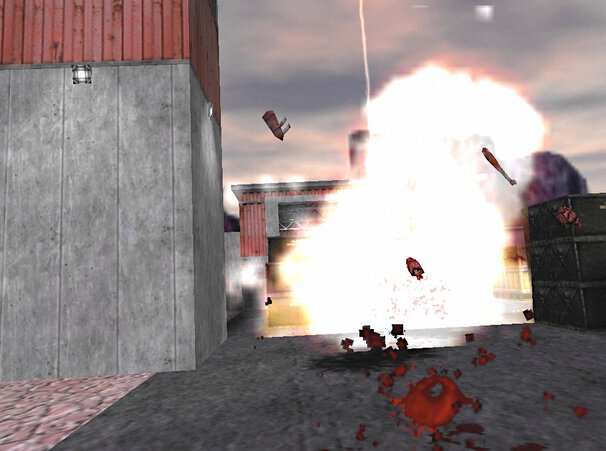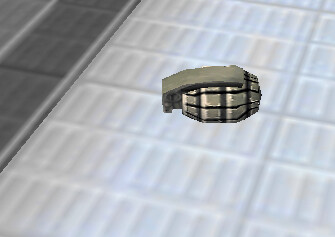12. Explosions¶
This page details the physics of explosion and explosive weapons, along with some speedrunning tricks that arise of out these aspects of the game. Familiarity with the health and damage system is assumed (see Health and damage).

Fig. 12.1. A powerful explosion created by a mortar strike in We’ve Got Hostile that gibbed a human grunt in one hit and inflicted some damage to the player from a distance.¶
12.1. General physics¶
An explosion, or radius damage, is a phenomenon in Half-Life that inflicts damage onto surrounding entities. In this section, we describe this phenomenon without associated with any entity such as grenades. On its own, an explosion is not visible. For instance, when a gauss beam reflects, an explosion is created at the point of reflection as described in Gauss. This explosion is completely invisible in-game, and a casual player would not notice that an explosion has occurred. Nevertheless, the game usually creates a fiery cosmetic effect to accompany an explosion for better gameplay, an example of which may be seen in Fig. 12.1..
Fig. 12.2. Illustration of the three main properties used to describe an explosion, namely the origin at the centre of the explosion, the source damage at the origin, and the radius of explosion. Here, it is assumed that nuking (see Nuking and headshots) is not done, and so the damage falls off linearly with distance from origin.¶
We may describe an explosion in terms of three fundamental properties. Namely, as illustrated in Fig. 12.2., an explosion has an origin 1, a source damage, and a radius. Suppose an explosion occurs. Let be its source damage and its radius, as shown in Fig. 12.2.. Suppose there is an entity adjacent to the explosion origin. From gaming experience, we know that the further away this entity is from the explosion origin, the lower the damage inflicted on this entity. In fact, the game only looks for entities within a sphere of radius from the explosion origin, ignoring all entities beyond. In the implementation, this is achieved by calling UTIL_FindEntityInSphere with the radius as one of the parameters.
For each entity within units from the explosion origin, the game traces a line from the explosion origin to the entity’s body target. Recall from Entities that the body target of an entity is usually, but not always, coincident with the entity’s origin. Then, assuming the line trace is not startsolid, the game computes the distance between this entity’s body target and the explosion origin as . The damage inflicted onto this entity is given by
Observe that the damage inflicted attenuates linearly with distance, also illustrated in Fig. 12.2., rather than the square of distance as is the case in the real world by the inverse square law.
If the line trace is startsolid, however, the game sets . As a result, the damage inflicted on the entity exactly equals the source damage of the explosion regardless of the actual distance of the entity from the explosion origin. The line trace being startsolid appears to be impossible in the game. Intuitively, we expect explosions to happen not inside a solid body, because grenades collide with solid entities and cannot enter them. Fortunately, this edge case is not hard to exploit in game, the act of which is named nuking as will be detailed in Nuking and headshots. The key to understanding how such exploits might work is to observe that the explosion origin may not coincide with the origin of the entity when the entity detonates. The exact way the explosion origin is computed depends on the type of entity generating the explosion.
12.2. Grenade explosions¶
Grenades are the primary source of explosions in Half-Life, and they share similar physics. For example, the explosion radius of all grenades described in this section depends on the source damage , with
This allows us to rewrite the attenuated damage in (12.1) for grenades as
The explosion origin as a result of a grenade detonation is more complicated. When a grenade explodes, the explosion origin may be different from the origin of the grenade entity. Denote the position of the grenade. When an explosion occurs, the game will trace a line from to . The exact coordinates of these two points depend on the type of the grenade which will be described in the later parts of this section, but they are always, in one way or the other, offset from the grenade’s origin. In general, we call the end position from the line trace. If the trace fraction is not 1, the game will modify the position of the grenade. Otherwise, the position of the grenade will not change and .
Assuming the trace fraction is not 1, is the normal of the plane hit by the line trace, and is the source damage of the grenade, the new position of the grenade is computed to be
All numerical constants are hardcoded. Call the coefficient of , or
the pull out distance, as per the comments in the SDK in ggrenade.cpp. This is so named because a grenade is typically in contact with some plane or ground when it explodes. By modifying the grenade origin this way, it is being pulled out of the plane by that distance. Remarkably, this distance depends on the source damage of the explosion. For instance, an MP5 grenade creates an explosion with a source damage of . Its pull out distance is therefore 45.6 units at detonation.
Having computed the new grenade position , the explosion origin for the actual explosion is set to be where is the axis unit vector (see 1 for an explanation). The rest of the physics is described in General physics.
12.2.1. Contact grenades¶
A contact grenade is a type of grenade which detonates upon contact with a solid entity. This includes the MP5 grenades and RPGs.
Fig. 12.3. Illustration of a contact grenade striking a surface and computing position of the the explosion origin . The line is tangent to the trajectory at the final position.¶
Let be the origin of a contact grenade moving in space. Assuming the map is closed, the grenade will eventually hit some entity and then detonate. Denote unit vector the normal to the plane on the entity that got hit. Note that at the instant the grenade collides with the plane, its position will be on the plane. Thus at this instant, let be the velocity of the grenade.
Then, the start and end points of the line trace are given by
Here, is 32 units away from the position of the grenade at collision, in the opposite direction of its velocity. And is 32 units away from that position, but in the direction of the velocity. It is easy to imagine that, more often than not, the end position of the line trace will coincide with the grenade position. This line trace will also rarely be startsolid. This is because the grenade has to pass through open space before hitting the plane, and is approximately one of the grenade’s past positions.
12.2.2. Timed grenades¶
Timed grenades are grenades that detonate after a specific amount of time. This includes hand grenades, which explode three seconds after the pin is pulled.

Fig. 12.4. The handgrenade is the most common example of a timed grenade.¶
Denote the origin of a timed grenade. At detonation, the grenade may or may not be lying on a plane. Since the grenade could well be resting on the ground with zero velocity, it does not make sense to use the velocity in computing the start and end points for the line trace as is the case for contact grenades in Contact grenades. Instead, Valve decided to use to offset those points from the grenade origin. So, we have
Now, is simply 8 units above the grenade and is 32 units below the grenade. This means that there is a greater chance that this line trace is startsolid and also that the trace fraction is 1. The former can occur if there is a solid entity very close above the grenade, while the latter can occur if the grenade is sufficiently high above the ground.
12.2.3. Explosions by env_explosion¶
An env_explosion is an invisible entity that can explode, which may be created by monsters, explosive func_breakable creates, or map designers. Although it does not subclass from the grenade class, its explosion physics is very similar. Denote the origin of the env_explosion. Then
Notice that the and for this entity type is similar to that of a timed grenade.
12.2.4. Tripmines¶
A tripmine is a grenade that detonates when it is “killed”. In this context, a tripmine can be killed by some external damage or by something blocking the beam.
Denote the origin of a tripmine, and the tripmine’s unit forward vector (unrelated to the player’s unit forward vector). Then we have
The unit forward vector is very well defined in the game, because it is parallel to the beam.
12.2.5. Detonating grenades¶
A detonating grenade is an explosive that can only be detonated via some in-game triggers or interactions. The satchel charge described in Satchel charge is the primary example of a detonating grenade. Let be the origin of a detonating grenade. Then we have
Compared to a timed grenade or an env_explosion entity, the is located deeper beneath the entity.
12.3. Nuking and headshots¶
There are two techniques that can increase the damage potential of explosions under certain conditions. One of them is commonly referred to in the community as nuking, while the other is a simple headshot. These two independent techniques have created some confusions among speedrunners, because “nuking” is misleading and players are generally unaware that an explosion can headshot.
Recall in General physics that, in any explosion, the game searches for entities within some radius from the explosion origin to inflict damage. For each entity, the game performs a line trace towards the entity’s body target. Similar to a normal gunshot, this line trace can strike any hitbox associated with the entity. If the line trace happens to hit the head, this constitutes a headshot. If the entity receives three times the damage for headshots, the attenuated damage given by (12.1) will be tripled. In some sense, this phenomenon deserves to be named “nuking”, justified by the dramatic increase in inflicted damage.
In the community, nuking commonly refers to the trick of placing explosives in locations confined in a particular way so as to disable damage attenuation computed by (12.1). The result is that the original source damage will inflict onto all entities found within the sphere of radius , as though all the entities coincide with the explosion origin with effectively . If we write the attenuated damage as a function of , then we have . The usefulness of this trick is obvious. It is important to keep in mind that the source damage and the explosion radius does not change when nuking. Entities outside the sphere will remain untouched by the explosion. It is also possible to headshot entities by nuking, which would deal a damage of to the entities. Based on the physics of nuking, a more correct name for the technique may be disattenuation.
Fig. 12.5. Comparison of how damage varies with distance from the explosion origin for normal explosions, nuking, and their headshots if applicable for the target entity.¶
Nuking is typically achieved by detonating an explosive so that the explosion origin given by (12.2) is inside some solid entity, which makes startsolid true when tracing a line from the explosion origin to any damageable entity. For example, an MP5 grenade touching the ground with a damage of 100 will explode with the origin 46.6 units above the ground. If this position is inside some solid entity, nuking will occur. Similarly, a handgrenade will cause nuking if the point 46.6 units above it is inside a solid entity.
Footnotes
- 1(1,2)
To be precise, we define the explosion origin to be the point where the line trace to search for entities nearby starts from, corresponding to the
UTIL_FindEntityInSpherefunction in the SDK. A careful reader may notice that this position is not the same as thevecSrcpassed into theRadiusDamagefunction, as the game adds tovecSrcbefore performing the search:vecSrc.z += 1;// in case grenade is lying on the ground
Despite the comment referring to “grenade”, this is done for all explosions regardless of the associated entity, if any.

